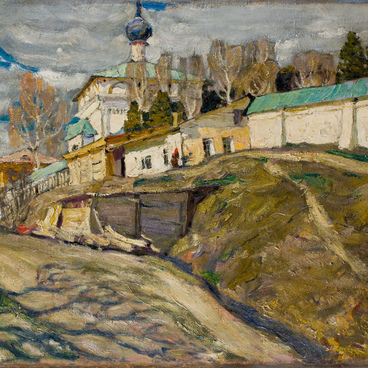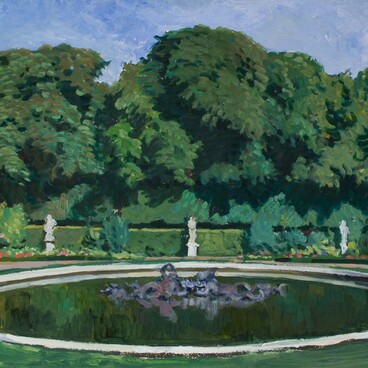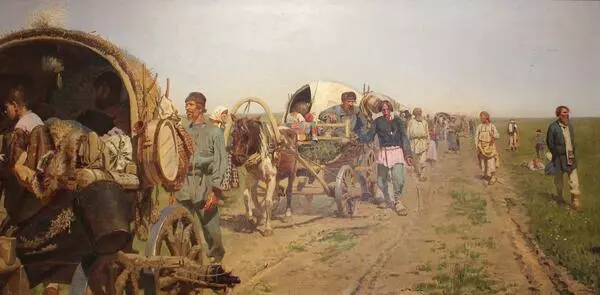Sergey Ivanov was a Russian painter, artist of the Peredvizhniki group (The Itinerants in English), and academician of the Imperial Art Academy. During his studies at the Moscow School of Painting, Sculpture and Architecture, his teachers were Illarion Pryanishnikov (1840–1894) and Evgraf Sorokin (1821–1892). Pryanishnikov was one of the founders of the Association of Itinerant Artists. Sorokin was a master of historical, religious and genre painting. These two mentors strongly influenced the formation of the painter’s personality.
In the 1880s-1890s, Sergei Ivanov was already a recognized master and one of the best painters of his generation, along with the painters Korovin, Levitan, and Serov. Ivanov was carried away by difficult moments in the history of Russia, he admired the strength of character and the beauty of the soul of the Russian people. One of the main themes in his work was the historical topic of the so-called “resettlement”, dedicated to the mass exodus of peasants from the central provinces at the end of the 19th century to Siberia.
The resettlement of peasants began after the abolition of serfdom in Russia in 1861. For the most complete immersion in this topic, the artist set out on a journey together with peasant families, having received a certificate from the Moscow Art Society “for travel and residence” from the Moscow province to the Orenburg province. Throughout the entire journey, together with the peasants, he experienced the whole palette of moods and in his paintings reflected everything that he saw and felt, masterfully conveying the difficult drama of important historical moments. For a long time, the artist worked on finding types, recreating the costumes and life of the Russian people. New color and compositional solutions, unusual angles, and decorative color spots highlight the influence of impressionism on Ivanov’s work.
The work ‘Maslenitsa’ is a vivid example of adherence to the style of the Impressionists. Wide strokes, bright colors, and a lot of air - all these impressionistic techniques create the effect of movement. The painting depicts a fragment of the celebration that passed into the stage of the wide Maslenitsa. Having dressed in all the most elegant and beautiful, the people literally poured out into the street, and with joy and on a grand scale participate in cheerful Maslenitsa festivities and amusements. The painting perfectly conveys the mood of one of the most beloved folk festivals. The work was donated to the museum in 1910 by the author himself.
In the 1880s-1890s, Sergei Ivanov was already a recognized master and one of the best painters of his generation, along with the painters Korovin, Levitan, and Serov. Ivanov was carried away by difficult moments in the history of Russia, he admired the strength of character and the beauty of the soul of the Russian people. One of the main themes in his work was the historical topic of the so-called “resettlement”, dedicated to the mass exodus of peasants from the central provinces at the end of the 19th century to Siberia.
The resettlement of peasants began after the abolition of serfdom in Russia in 1861. For the most complete immersion in this topic, the artist set out on a journey together with peasant families, having received a certificate from the Moscow Art Society “for travel and residence” from the Moscow province to the Orenburg province. Throughout the entire journey, together with the peasants, he experienced the whole palette of moods and in his paintings reflected everything that he saw and felt, masterfully conveying the difficult drama of important historical moments. For a long time, the artist worked on finding types, recreating the costumes and life of the Russian people. New color and compositional solutions, unusual angles, and decorative color spots highlight the influence of impressionism on Ivanov’s work.
The work ‘Maslenitsa’ is a vivid example of adherence to the style of the Impressionists. Wide strokes, bright colors, and a lot of air - all these impressionistic techniques create the effect of movement. The painting depicts a fragment of the celebration that passed into the stage of the wide Maslenitsa. Having dressed in all the most elegant and beautiful, the people literally poured out into the street, and with joy and on a grand scale participate in cheerful Maslenitsa festivities and amusements. The painting perfectly conveys the mood of one of the most beloved folk festivals. The work was donated to the museum in 1910 by the author himself.





